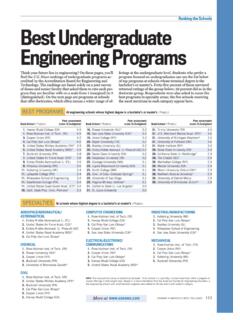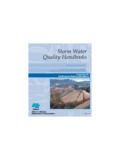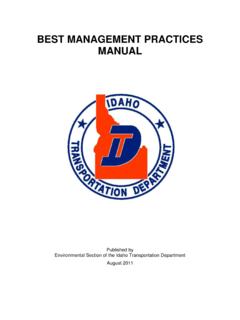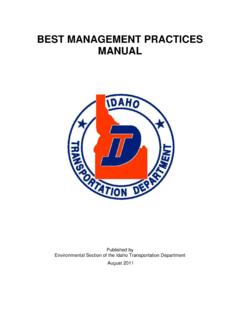Transcription of Pennsylvania Stormwater Best Management Practices Manual
1 Pennsylvania Stormwater best Pennsylvania Stormwater best Management Practices ManualManagement Practices ManualIn cooperation with:Presented by the Pennsylvania Department of Environmental ProtectionBureau of Watershed ProtectionStormwater Oversight CommitteeVillanova Urban Stormwater PartnershipCahill AssociatesEnvironmental information ( Manual revisions, meetings, training, etc.) will be posted on the DEP Stormwater page DEP Keyword: Stormwater General information Stormwater Oversight committee Draft Stormwater best Management Practices Manual Cover and Table of Contents Section 1 - Introduction and Purpose of BMP Manual Section 2 - Stormwater and PA's Natural Systems Section 3 - Stormwater Management Principles, Goals, and a Management Model Section 4 - Comprehensive Stormwater Management : Integrating Site Design, Non-Structural, and Structural BMP's Section 5 - Comprehensive Stormwater Management : Non-Structural BMP's Section 6 - Comprehensive Stormwater Management .
2 Structural BMP's Section 7 - Stormwater Management for Special Areas Section 8 - Stormwater Calculations and Methodology Section 9 - Case Studies Innovative Stormwater Management Approaches and Practices Appendix A - Water Quality Appendix B - Pennsylvania Native Plant List Appendix C - Soil Infiltration Testing, System Design and Construction Guidelines Appendix D - Case Study with Stormwater CalculationsChapter 1 Chapter 1 Introduction & PurposeIntroduction & Purpose To improve Stormwater Management throughout Pennsylvania . Emphasis on water quality and water resources. Describes Management methods and Practices that can prevent, reduce, and mitigate the impacts of ManagementStormwater Management Relationship Land Use and Water Integrated Approach Manage Stormwater : Volume Water Quality Peak Rate Groundwater Recharge Stream ImpactsCOMPREHENSIVESWPOLICYBMP TechnicalManualConstruction NPDESP ermitsNPDESP hase IIMS4 PermitsACT 167 PlanningProgramChapter 2 Chapter 2 Stormwater and PennsylvaniaStormwater and Pennsylvania s Natural Systemss Natural Systems Hydrologic Cycle.
3 Pennsylvania Rainfall: Avg. 36 to 44 . Impacts of Development and Impervious Surfaces. Water and Environmental Quality. Pennsylvania Watersheds, Soils, ImpactsStormwater Impacts Increased Runoff Volume Compacted Soils Erosion and Stream Channel Changes Decreased Base-flow Pollutants and Temperature Impacts Decreased Evapo-transpiration and Groundwater Recharge Increased Frequency of Runoff Events Faster Conveyance of Water Impacted Aquatic LifeWELLSTREAMAQUIFERBEDROCKSOILWATER TABLE (DEVELOPED CONDITIONS)Green Valleys AssociationCahi ll AssociatesEnvi ronmental Consul tantsChapter 3 Stormwater Management Principles and GoalsRecommended Site Control Guidance: Comprehensive Watershed; Hydrology. Effective Prevents impacts. Equitable New and re-development. Flexible Variable conditions; Principles for Stormwater Ten Principles for Stormwater ManagementManagement Prevent Stormwater impacts first.
4 Mitigate second. Manage Stormwater as a resource. Maintain water cycle balance-quality and quantity. Integrate Stormwater in the initial site design. Preserve and utilize natural systems-soil, vegetation. Manage Stormwater close to the source. Disconnect/Decentralize/Distribute. Slow it down, don t speed it up. Do as much with as little as Control GuidanceSite Control GuidanceVolume CG-1Do not increase runoff volume, pre-development to post-development, for up to the 2-year frequency, 24-hour duration rainfall. **Volume CG-2 Capture and remove runoff generated by inches of rainfall with infiltration of the runoff from the initial inches of tende d De tention (CG-2 only)Provide 24-hour extended detention of the 1-year frequency, 24-hour duration Conservation/ Stream Channel ProtectionFlood Protection: 1- through 100-Year Storms, Site by SiteCumulative Flood Protection as Needed through Act 167 PlanningGroundwater QualitySurface Water Quality - reduction of 85% particulate-associated NPS; reduction of 50% solute loads Temperature** Existing (pre-development) non-forested pervious areas must be considered meadow or its Water Table/ Stream Base Flow & Stream Conservation/ Stream Channel Protection* These guidelines are recommended for use in watersheds throughout Pennsylvania .
5 Guidelines may be further modified in Special Stormwater Management Areas and other zones where different Stormwater guidelines for quantity and quality control are warrantPeak Rate (CG-1 a nd CG-2)Do not increase peak rate of runoff for larger storms (1-, 2-, 10-, 25-, 100-year storms at minimum), pre-development to post-development; as necessary, provide additional peak rate control for largest storms through the Act 167 Quality (CG-1 a nd CG-2)A reduction of 85% of particulate-associated pollutants (as represented by TSS), including 85% of Total Phosphorus. In addition, removal or prevention of 50% of solutes (as represented by NO3-N) is required. BMPs shall not result in a temperature increase of 3 degrees Guidance 1 Control Guidance 1 Do not increase the post development total runoff discharge volume for up to the 2 year storm.
6 Flood protection peak rates held to existing levels for the 1 100 year : Existing condition is defined as those that occurred predevelopment, the current land cover (including impervious area). Existing non-forested pervious areas are classified as meadow or its Guidance 2 Control Guidance 2 Base flow Infiltrate runoff from the first 1/2 of rainfall. Calculated as x impervious area. Water Quality Infiltrate or capture runoff from the next 1 of rainfall. Capture is defined as permanent removal from runoff volume. Volume credits added to promote green Practices . Channel Protection Control the 1 year peak discharge to the equivalent flow achieved by 24 hour extended detention of 1 year, 24 hour storm. Flood Protection Peak Rates held to existing levels for the 1 100 year 4 Chapter 4 Integrating Site DesignIntegrating Site Design Comprehensive design process.
7 Emphasize non-structural BMP value. Stormwater not an 5 Chapter 5 NonNon--Structural BMPsStructural BMPs Each technique presented as a BMP. Incentives and values for non-structural BMPs. Emphasis on preventing/reducing Stormwater . Soils Vegetation Reduced impervious surfaces. Natural area conservation. Small scale structural Protect sensitive/special value features. - Protect/conserve/enhance utilize riparian Protect/utilize natural flow pathways in overall Stormwater planning and Sensitive and Special Value Resources- Cluster uses at each site; build on the smallest area Concentrate uses areawide through smart growth and Concentrate-Minimize total disturbed area grading. - Minimize soil compaction in disturbed Re-vegetate and re-forest disturbed areas, using native Disturbance and Minimize Maintenance- Reduce street Reduce parking Impervious Cover- Rooftop from storm from storm ControlSource Control- Street 6 Chapter 6 Structural BMPsStructural BMPs Volume/Peak Rate by Infiltration.
8 Volume/Peak Rate Reduction BMPs. Quality/Peak Rate Reduction BMPs. Restoration. BMPs Structural BMPs Volume/Peak Rate by InfiltrationVolume/Peak Rate by Infiltration Porous Pavement Infiltration Basin Infiltration Trench Dry Well / Seepage Pit Rain Garden/Bioretention Vegetated Swale Constructed Filter Infiltration Bed Vegetated Filter Strip BermVolume/Peak Rate Reduction BMPs Vegetated Roof Rooftop Runoff Capture & ReuseRunoff Quality/Peak Rate BMPsRunoff Quality/Peak Rate BMPs Constructed Wetland Wet Pond / Retention Basin Dry Extended Detention Basin Water Quality FilterRestoration BMPs Landscape Restoration Riparian Buffer Restoration Soils Amendment & RestorationOther BMPs Level Spreader Special Detention Areas Parking Lot, RooftopBMP ElementsBMP Elements One- page Overview Description and Pictures AutoCAD Details Variations Applications (examples)
9 Design Considerations Detailed Stormwater Functions Construction Sequence Maintenance Issues Cost Information Specifications10 to 15 pages per BMPS tructural BMPsStructural BMPs One-page Overview: Snapshot of Key Design/Function Elements Description, Diagrams, and PicturesStructural BMPs ContStructural BMPs Cont Design Considerations Detailed FunctionsStructural BMPs ContStructural BMPs Cont Maintenance Considerations Cost Issues SpecificationsChapter 7 Chapter 7 Stormwater Management for Special Stormwater Management for Special AreasAreas Urban areas. Mined lands. Highways and Roads. Karst areas. Brownfields. Source water protection AreasUrban AreasStormwater BMP Challenges in Stormwater BMP Challenges in Urban AreasUrban imperviousness (50% to 100%). property values, limited physical space, soils, impacted streams; enclosed/buried in of the original floodplain.
10 Connection of impervious surfaces. levels of trash, debris and pet Stormwater hot spots : industrial areas, vehicle service areas, public works storage areas, dumpsters, Regulations and ordinances that may conflict with current BMP design Limited economic resources; need to encourage rather than discourage and RoadsHighways and RoadsConstituentSourceParticulatesPaveme nt wear, vehicles, atmospheric deposition, maintenance activitiesNitrogen, PhosphorusAtmospheric deposition and fertilizer applicationLeadLeaded gasoline from auto exhausts and tire wearZincTire wear, motor oil and greaseIronAuto body rust, steel highway structures such as bridges and guardrails, and moving engine partsCopperMetal plating, bearing and bushing wear, moving engine parts, brake lining wear, fungicides and insecticidesCadmiumTire wear and insecticide applicationChromiumMetal plating, moving engine parts, and brake lining wearNickelDiesel fuel and gasoline, lubricating oil, metal plating, bushing wear, brake lining wear.















